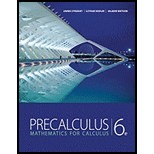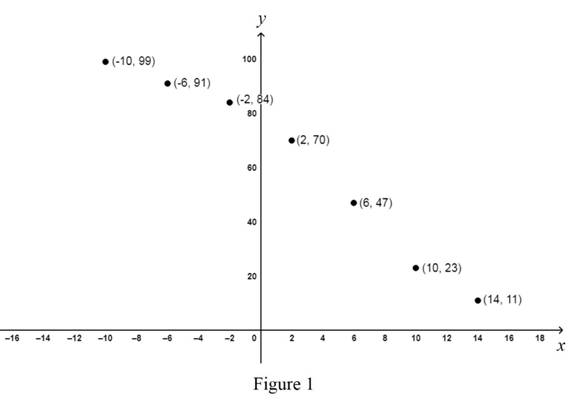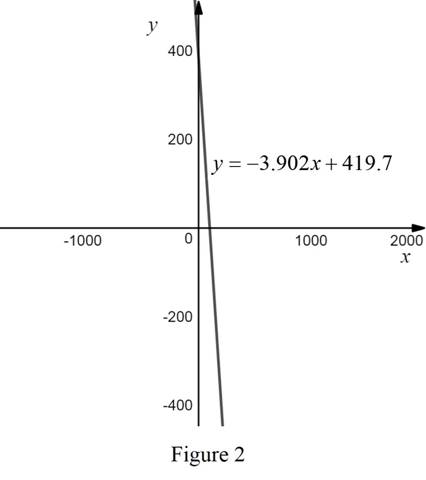
Noise and Intelligibility Audiologists study the intelligibility of spoken sentences under different noise levels. Intelligibility, the MRT score, is measured as the percent of a spoken sentence that the listener can decipher at a certain noise level in decibels (dB). The table shows the results of one such test.
- (a) Make a
scatter plot of the data. - (b) Find and graph the regression line.
- (c) Find the
correlation coefficient . Is a linear model appropriate? - (d) Use the linear model in part (b) to estimate the intelligibility of a sentence at a 94-dB noise level.
| Noise level (dB) | MRT score (%) |
| 80 | 99 |
| 84 | 91 |
| 88 | 84 |
| 92 | 70 |
| 96 | 47 |
| 100 | 23 |
| 104 | 11 |
(a)
To graph: The scatter plot of the data.
Explanation of Solution
Graph:
Consider the Noise level in decibel as the x coordinates and the M.R.T score as the y coordinates.
The scatter plots of the given data are shown below in Figure 1.

From Figure 1, all the points are plotted on the graph. No two points coincide each other.
(b)
To find: The regression line that represents the given data and draw the graph for it.
Answer to Problem 8P
The regression that represents the given data is
Explanation of Solution
By the use of online calculator, the regression line for the given data obtained is
The above regression line is in the form of linear equation.
Therefore, the linear function that represents the given data is
The graph that represents the equation

From Figure 2, the graph for the linear equation
(c)
To find: The correlation coefficient and to check whether the linear model appropriate or not.
Answer to Problem 8P
The correlation coefficient is
Explanation of Solution
Formula used:
The formula for the correlation coefficient is
Calculation:
Compute the values of the summation of x, y, xy,
| x | y | xy |
|
|
| −10 | 99 | −990 | 100 | 9801 |
| −6 | 91 | −546 | 36 | 8281 |
| −2 | 84 | −168 | 4 | 7056 |
| 2 | 70 | 140 | 4 | 4900 |
| 6 | 47 | 282 | 36 | 2209 |
| 10 | 23 | 230 | 100 | 529 |
| 14 | 11 | 154 | 196 | 121 |
|
|
|
|
|
|
It is observed that the value of n = 7.
Substitute the values that are obtained in the table to compute the correlation coefficient by using the above mentioned formula.
On further simplification.
Thus, the value of the correlation coefficient is
(d)
To find: The estimate value of the intelligibility of a sentence at a 94-dB.
Answer to Problem 8P
The estimate value of the intelligibility of a sentence at a 94-dB is 52.912 %.
Explanation of Solution
Consider the noise level at 94-dB.
From part (b), it is obtained that the linear equation that represents the given data is
Substitute x = 94 in the above equation to compute the M.R.T score.
Thus, the estimate value of the intelligibility of a sentence at a 94-dB is 52.912 %.
Chapter 1 Solutions
EBK PRECALCULUS: MATHEMATICS FOR CALCUL
- After a great deal of experimentation, two college senior physics majors determined that when a bottle of French champagne is shaken several times, held upright, and uncorked, its cork travels according to the function below, where s is its height (in feet) above the ground t seconds after being released. s(t)=-16t² + 30t+3 a. How high will it go? b. How long is it in the air?arrow_forward+6x²+135x+1) (0≤x≤10). a) Find the number of units The total profit P(x) (in thousands of dollars) from a sale of x thousand units of a new product is given by P(x) = In (-x²+6x² + 135x+ that should be sold in order to maximize the total profit. b) What is the maximum profit?arrow_forwardThe fox population in a certain region has an annual growth rate of 8 percent per year. It is estimated that the population in the year 2000 was 22600. (a) Find a function that models the population t years after 2000 (t = 0 for 2000). Your answer is P(t) = (b) Use the function from part (a) to estimate the fox population in the year 2008. Your answer is (the answer should be an integer)arrow_forward
- rarrow_forwardThe solutions are 1 where x1 x2- ● Question 11 Solve: x 54 Give your answer as an interval. Question 12arrow_forwardA population of deer in Pierce County currently has 1875 deer, but due to urban development, the population is decreasing at a rate of 1.1% a year. a) Assuming this growth rate continues, find the formula for a function f(t) describing this population. b) In how many years will the population reach 1300? Do the problems on your own paper, show all your work, and submit your scanned work below. Choose File No file chosenarrow_forward
- Question 3 Rewrite 4 = log₂(16) in exponential form. Question 4 症 If log, (6x+3)= 4, then rarrow_forwardQuestion 6 Find the solution of the exponential equation 2t 100(1.07) 2 = 500,000 in terms of logarithms, or correct to four decimal places. t=arrow_forwardQuestion 6 Find the solution of the exponential equation 100(1.07)² = 500, 000 in terms of logarithms, or correct to four decimal places. t = Question 7 Solve the equation.arrow_forward
 Calculus: Early TranscendentalsCalculusISBN:9781285741550Author:James StewartPublisher:Cengage Learning
Calculus: Early TranscendentalsCalculusISBN:9781285741550Author:James StewartPublisher:Cengage Learning Thomas' Calculus (14th Edition)CalculusISBN:9780134438986Author:Joel R. Hass, Christopher E. Heil, Maurice D. WeirPublisher:PEARSON
Thomas' Calculus (14th Edition)CalculusISBN:9780134438986Author:Joel R. Hass, Christopher E. Heil, Maurice D. WeirPublisher:PEARSON Calculus: Early Transcendentals (3rd Edition)CalculusISBN:9780134763644Author:William L. Briggs, Lyle Cochran, Bernard Gillett, Eric SchulzPublisher:PEARSON
Calculus: Early Transcendentals (3rd Edition)CalculusISBN:9780134763644Author:William L. Briggs, Lyle Cochran, Bernard Gillett, Eric SchulzPublisher:PEARSON Calculus: Early TranscendentalsCalculusISBN:9781319050740Author:Jon Rogawski, Colin Adams, Robert FranzosaPublisher:W. H. Freeman
Calculus: Early TranscendentalsCalculusISBN:9781319050740Author:Jon Rogawski, Colin Adams, Robert FranzosaPublisher:W. H. Freeman
 Calculus: Early Transcendental FunctionsCalculusISBN:9781337552516Author:Ron Larson, Bruce H. EdwardsPublisher:Cengage Learning
Calculus: Early Transcendental FunctionsCalculusISBN:9781337552516Author:Ron Larson, Bruce H. EdwardsPublisher:Cengage Learning





